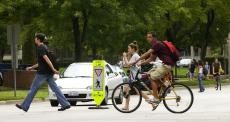Crosswalks promote safety cause confusion

Students cross at a crosswalk on Fourth Street on Aug. 26. The crosswalks, with their bright yellow signs positioned in the middle of the streets, stemmed from the ongoing Campus Area Transportation Study (CATS). Carol Matteucci
September 9, 2004
Five median crosswalks have been installed around campus to help ease the stress of both pedestrians and drivers on their daily commutes.
In response to safety issues on University streets, the Department of Facilities and Services added the new crosswalks over the summer, bringing the total number of crosswalks to seven.
“We want to enhance pedestrian safety and exhibit to the campus that our first priority is to the pedestrian,” said Gary Biehl, traffic engineer in Facilities and Services.
The crosswalks, with their bright yellow signs positioned in the middle of the streets, stemmed from the ongoing Campus Area Transportation Study (CATS). While crosswalks were previously installed on Springfield Avenue across from Grainger Library and at the corners of Goodwin Avenue and Illinois Street, CATS pinpointed other campus intersections with high volumes of student traffic.
“We’re trying to make drivers more aware of students crossing and to exercise more caution while driving,” said Kevin Duff, assistant director for Grounds and Landscape Architecture.
Get The Daily Illini in your inbox!
The new crosswalks were placed at the intersections of Fourth and John streets, and Fourth Street and Armory Avenue. Crosswalks were also placed on Fourth Street; one south of Huff Hall, one south of the Law Building, and one on Goodwin Avenue, just east of Bevier Hall. While Facilities and Services funded five of the seven crosswalks, the city of Urbana paid for the crosswalk at Goodwin Avenue and Illinois Street and the city of Champaign paid for the crosswalk at Fourth and John streets.
The University district maintains a 25 mph speed limit and signs proclaiming “Pedestrians Have the Right of Way” have dotted campus for several years, Biehl said.
“There’s a different feeling when you come on campus,” Biehl said. “We’re working to change the dynamics of the campus from a dominantly vehicular one to a more pedestrian-friendly one, without slowing travel time.”
However, while safety is the main goal of the crosswalks, University police have expressed their concern over the signs. While the crosswalks say “State Law: Vehicles Must Yield to Pedestrians in the Crosswalk,” officers like Lieutenant V.G. “Skip” Frost see the signs as confusing and misleading.
“The basic premise is that students think they have the automatic right of way in these crosswalks,” said Frost, a patrol division commander.
In reality, the state law says that no pedestrian shall leave the curb in a manner that could cause a vehicle to stop in a hazardous fashion, Frost said.
“Pedestrians only have the right of way if they are already physically in the crosswalk,” Frost said. “They cannot walk out into the street without looking both ways, or they will be crossing illegally.”
University police fear the crosswalks encourage pedestrians to run out into traffic, expecting vehicles to yield to them. The confusion about the crosswalks also works both ways, with some vehicles yielding even if the crosswalks are empty and some driving through them, despite the presence of pedestrians.
Melissa Van Vickle, senior in LAS, uses the crosswalks every day on her way back and forth from class and work.
“I watch to make sure cars are slowing down before I cross and most don’t stop,” Van Vickle said. “But without the crosswalks, I would have to run to beat the traffic.”
Frost said the crosswalks would better serve public safety if they were positioned at regulated traffic areas such as lights, stop signs or yield signs. Frost also said better education about the crosswalks and other pedestrian safety matters will help to serve the ultimate goal of the project.
“I’m very appreciative of the idea behind the crosswalks,” Frost said. “But there is potential danger if pedestrians do not understand the law.”
As the semester continues and students become more acquainted with the new crosswalks, Frost hopes that they will increase safety as they were intended, but encourages pedestrians and vehicles to take caution as they travel.
“It is a good idea if the crosswalks can promote public safety,” Frost said. “But it is ultimately up to the individual to pay attention to their own safety.”






